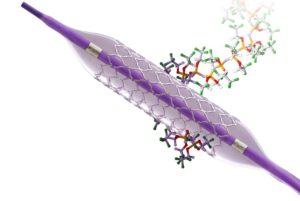
CeloNova BioSciences has announced interim results from the randomised Trial of COBRA PzF Stenting to REDUCE Duration of Triple Therapy (COBRA-REDUCE), the first randomised 14-day dual antiplatelet therapy (DAPT) study of high bleeding risk patients (HBR), during a late-breaking clinical science session at TCT Connect 2020 (14–18 October, virtual).
“Today marks a very significant milestone in providing valuable clinical insights into the DAPT duration and stent choice for high bleeding risk patients formally excluded from clinical trials,” stated Professor Robert Byrne (Royal College of Surgeons in Ireland [RSCI] University of Health Sciences, Dublin, Ireland), a principal investigator in the COBRA REDUCE trial.
“I would like to thank my colleagues for their outstanding support in successfully completing this portion of the study despite challenges brought on by the COVID-19 world pandemic. We look forward to concluding patient follow-up and secondary analysis at 12 months,” said Byrne.
In the COBRA REDUCE trial, 100% of enrolled patients were on oral anticoagulation therapy (OAC) with over 90% of patients presenting with atrial fibrillation (AF). OAC is a major bleeding criterion, per the Academic Research Consortium for high bleeding risk (ARC-HBR). Furthermore, close to half of all patients in the study share a second or third major or minor ARC-HBR bleeding criteria, such as recent ischaemic stroke, cancer, anaemia, or severe or end-stage chronic kidney disease. It was noted that significantly less patients in the COBRA PzF NCS arm received a reduction in OAC intensity compared to the DES arm (COBRA: 46% vs. DES: 56%; p=0.006). Both study arms presented with highly complex lesions and the COBRA PzF NCS arm presented with statistically higher bifurcation rates (COBRA: 20% vs DES: 15%; p=0.034).
The COBRA REDUCE study randomised 996 HBR patients across 59 enrolling global sites to receive either COBRA PzF NCS (n=495) with 14-day DAPT or an FDA-approved DES (n=501) with three or six months DAPT. COBRA PzF NCS demonstrated the following interim results:
- Numerically less bleeding in the co-primary endpoint of BARC class ≥2 bleeding after 14 days (COBRA: 7.5% vs DES: 8.9%; p=0.477) and statistically less bleeding over DES in BARC class 1-5 after randomization (COBRA: 13% vs. DES: 18.3%; p=0.026).
- Numerically similar rates in the composite co-primary endpoint of ischemic safety compared to the DES arm (COBRA: 7.7% vs DES: 5.2%; p=0.061). Additional analysis showed statistical non-inferiority when the composite endpoint includes only cardiac-related mortality.
- Equal low probable and definite stent thrombosis (0.6%) in both groups (not powered).
- Low initial ischemic-driven TLR at 6 months (3.7%).
“We are pleased with COBRA PzF NCS’ preliminary performance with just 14-days DAPT in aspects of bleeding and ischemic events,” said Carl St Bernard, president and chief executive officer of CeloNova. “Finding the right DAPT balance is critical to reducing the complexity and complications of long-DAPT regimens following stent placement. The COBRA REDUCE study has advanced our understanding of how to best strike this balance.”
“It is encouraging to see that the COBRA stent demonstrated a very low stent thrombosis rate with just 14-days DAPT in this high-risk patient population,” said Roxana Mehran (Icahn School of Medicine at Mount Sinai, New York, USA) and a member of the COBRA REDUCE steering committee. “We hope to gain further insight into its efficacy with 14-days DAPT in the secondary analysis at 12 months.”
COBRA REDUCE’s final co-primary endpoint analysis and secondary endpoints, including composite of all-cause death, cardiac death, MI, ischemia-driven TLR, definite and probable stent thrombosis and ischemic stroke at 12-months, are expected to be revealed in Q2 of 2021.













